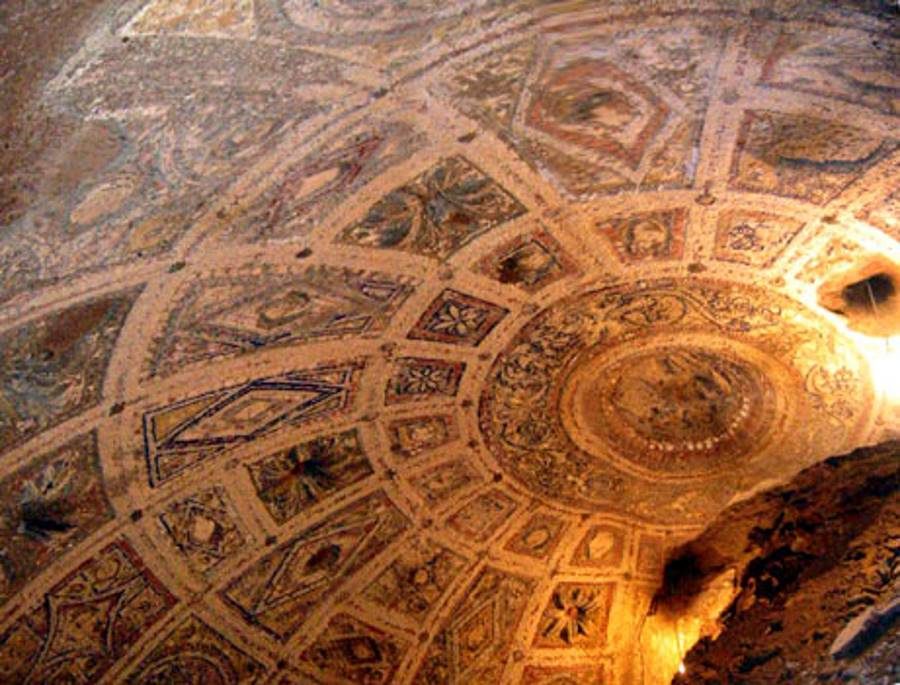
© Associated Press/Italian Culture Ministry, HOLupercale ceiling picture
Archaeologists say they have unearthed Lupercale - the sacred cave where, according to legend, a she-wolf nursed the twin founders of Rome and where the city itself was born.
The long-lost underground chamber was found beneath the remains of Emperor Augustus' palace on the Palatine, a 230-foot-tall (70-meter-tall) hill in the center of the city.
Archaeologists from the Department of Cultural Heritage of the Rome Municipality came across the 50-foot-deep (15-meter-deep) cavity while working to restore the decaying palace.
"We were drilling the ground near Augustus' residence to survey the foundations of the building when we discovered the cave," said Irene Iacopi, the archaeologist in charge of the area.
"We knew from ancient reports that the Lupercale shouldn't be far from the Emperor's palace, but we didn't expect to find it. It was a lucky surprise.
"We didn't enter the cave but took some photos with a probe," Iacopi added.
"They show a richly decorated vault encrusted with mosaics and seashells, too rich to be part of a home. That's why we think it could be the ancient sanctuary, but we can't be sure until we find the entrance to the chamber."
Ancient LegendAccording to myth, Lupercale is where a she-wolf suckled Romulus and Remus, the twin sons of the war god Mars and mortal priestess Rhea Silvia, who had been abandoned in a cradle on the bank of the Tiber River.
The cave's name, in fact, comes from the Latin word for wolf, lupus.
The brothers are said to have later founded Rome on April 21, 753 B.C., at the site. But they eventually fought for the leadership of the new city, and Romulus killed his brother.
That didn't stop the site from becoming a sacred place to ancient Romans.
Every year on February 15 ancient priests killed a dog and two goats and smeared the foreheads of two boys from noble families with the sacrificial blood as part of the Lupercalia celebration.
The ceremony survived until A.D. 494, when Pope Gelasius put an end to the tradition.
The Palatine Hill also became the residential area of the most affluent Roman citizens beginning in 500 B.C.
When the Roman Republic became the Roman Empire in the first century B.C., Augustus even built himself and his wife Livia palaces on top of the hill.
Later emperors followed his example and built larger and larger homes on the same spot. Now the whole hill is a honeycomb of buildings and tunnels extending far underground.
The English word "palace" derives from "Palatium," the Latin name of the area.
Crumbling Ruins"The tale of the birth of Rome is part myth and part historical truth," said Andrea Carandini, historian and archaeologist at the University of Rome, La Sapienza.
"The story of the twins reflects the previous tradition of the Lares, the twin deities protecting the area, but there was indeed a historical founder who constituted the Palatine Hill as the sacred heart of the city around 775 B.C.," he added.
"The archaeological findings are providing more and more evidence that the tale of Rome's foundation isn't a later legend but originates from historical facts," he said.
Time may been running out for additional discoveries, however.
"The remains are now crumbling due to atmospheric agents and lack of funds for maintenance," head archaeologist Iacopi said. "Most of the buildings are closed to the public for safety reasons. It's a real pity.
"Archaeologists are doing what they can to restore and stabilize the ruins," she added.
"Now we have to find the entrance and study the chamber," Iacopi said.
"In the meantime we are going to finish the restorations in Augustus' palace. We hope to open part of the emperor's residence to the public in a few months."
Reader Comments
to our Newsletter